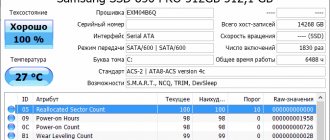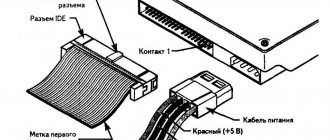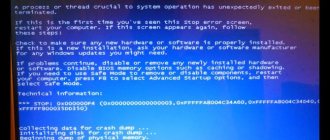Correct shutdown is an important condition for trouble-free computer operation. And if your bosom friend Windows suddenly stops turning off correctly, you should pay attention to it and figure out what’s wrong. We shouldn’t constantly hit our friends on the wrist just because they are in no hurry to fulfill our desires. And this is exactly what we do when we manually turn off the power, not understanding why, in response to our command, the laptop or computer does not turn off completely. In 90% of cases, it is possible to diagnose and eliminate the cause independently, without contacting a service center.
Symptoms and causes
Shutdown errors in Asus, Lenovo or HP models with operating systems: Windows 7, 8, 10, Windows XP - appear in several scenarios.
- Windows does not respond to the “Shutdown” / “Restart” command in the Start menu - it does not hear it.
- The shutdown process seems to be starting: after the corresponding commands, the message “Shutting down...” appears - and the system freezes at this stage. The screen does not go off, the power does not turn off, the “Power” and “wi-fi” indicators are lit.
- The standard end of the session occurs - the screen goes dark. But the fan continues to work, the buttons light up, the energy source does not turn off by pressing the power button or closing the laptop lid.
The Shutdown step does not turn off the computer
The causes of the problems are rooted in software failures, OS errors, incorrect driver operation, BIOS system violations, and, finally, failures of the device itself.
- Software – programs installed in addition to system folders. New software may conflict with the operating system, slow down and block its operation. Among the new software there may be virus programs: suspicious processes appear in the task manager, the laptop begins to slow down, the anti-virus program freezes during scanning and turns off. The inability to end a session manifests itself in type 1 - Windows does not hear the command and does not react to it in any way.
- Operating system errors - appear when updating it, which causes a conflict between new applications and old ones (occurs when updating the OS to Windows 10). When the session ends, some applications and services continue to work - then “Shutting down...” will scroll endlessly on the blue screen. An application conflict may manifest itself in the third scenario: the screen will go dark, but the system will not turn off even when you press and hold the Power button and lower the laptop lid.
- Drivers may prevent your computer from turning off. Such surprises are often presented by updated or newly installed Intel products.
- BIOS system failure - this basic program is located on the motherboard and regulates the operation of the computer with all devices connected to it. In laptops of a respectable age (more than 5 years), the BIOS battery life may be depleted and the microcircuit may be damaged. A BIOS failure manifests itself in the fact that the laptop cannot disconnect on its own from the power source, does not reboot, and does not go to sleep.
- Hardware faults - damage to the hard drive, motherboard, video card, etc. In such cases, the endless termination of the session is accompanied by additional symptoms: the computer slows down when turned on, a blue screen of death (BSoD) appears from time to time, and RAM defects are detected.
Software errors can be corrected independently; in extreme cases, you can call a technician to your home, but with hardware problems, the laptop/computer must be taken to a workshop.
BSoD - blue screen of death, shows critical errors that the Windows system could not cope with
List of main problems that prevent your computer from starting and methods for solving them
Let's take a look at the common causes of problems and consider recommendations for dealing with them.
To completely eliminate damage to the power cord, use a special tester. If this is not available, you can connect another cord and see if the computer turns on.
detect a faulty switch on the power supply in an extremely simple way. Switch it to another position. There may be a light next to it, if the indicator does not work or there is no mechanical switching sound, the component is probably faulty.
Also, the functionality of the unit can be checked in another, but more dangerous way. For experienced users only - you are responsible for all actions! Pick up the largest connector of the power supply unit, which connects to the mother. Find the green wire and the adjacent black wire on it (there is only one green wire). Connect them using a paper clip or a piece of wire with the ends stripped. Now plug the PSU into the outlet and activate the power switch. If the cooler is noisy, then the power supply is fundamentally good; if it doesn’t respond, it’s most likely time to buy a new power supply.
If everything is theoretically normal with the unit, suspicion falls on the power button; to check it, you should do the following:
- Unplug the device from the outlets;
- Disconnect the side cover of the “system unit”;
- Find two wires going from the start key to the motherboard (they are connected with plastic connectors; power sw is usually written on the connector and on the board near the connector);
- Next, we disconnect them and replace these two contacts with some small metal analogue that passes current (you can briefly touch it with a screwdriver or paper clip).
If everything works, but there is no image on the monitor , replacing the cable connecting the video adapter to the monitor may help. If the picture still does not display, the monitor may be broken. It is also possible that the video card may fail.
The startup error could be caused by severe overheating of the CPU or video adapter. To do this, remove dust from inside the PC.
- Turn off the computer;
- You need to give all the internal parts a good cleaning;
- This is done with a brush; especially hard-to-reach places can be cleaned with an ear swab;
- We clean every part inside the case, including the motherboard, video chip, coolers, capacitors, RAM, HDD, all connectors, and so on;
- We remove the resulting debris with a vacuum cleaner;
- After cleaning, we try to start the equipment.
In case of overheating, we recommend replacing the thermal paste. You can carry out maintenance of the cooling system either manually (taking into account the availability of the necessary knowledge) or by contacting a service center.
Burnt smell from PSU
We urgently turn off the power to the PC. It is recommended to contact a workshop to replace failed components (with or without warranty). You can also fix the problem by replacing a certain component yourself, but this can only be done if you have the appropriate experience.
Quite often, operating system crashes followed by PC shutdown are associated with incorrectly connected peripheral equipment. For example, the mouse, keyboard and other controllers are connected to the wrong connectors. Disconnect all devices and press the Power key.
RAM stick offset
A similar situation arises as a consequence of a mechanical nature (various shocks, vibration, movement). First you need to turn off the power to the equipment and remove the module, then carefully put it back. If the RAM is installed correctly, you can try to turn on the computer.
When inspecting the PC case, we advise you to carefully check the connecting cables. The reliability of fastening the wires plays an important role in the proper functioning of the hardware.
Failure of one of the internal components
To identify which component is broken, you can take out the additional boards connected to the motherboard one by one. For example, you remove the WiFi adapter and try to turn on the computer. Did not help? Disconnect the sound card, try to turn it on again, and so on.
The PC should turn on if the board has a processor, RAM, a video card (if not built-in) and power is connected. The functionality of these components can only be checked by replacing them with similar ones. If there are several memory cards installed, you simply try to remove them one by one.
If you notice swelling or smudges on the motherboard
These are very bad symptoms. Most likely, the board will need to be repaired or replaced.
Not all fans in the system unit are spinning
Check that the wires between the cooler and the motherboard are connected correctly. The problem may also be a malfunction of the board itself or the power supply.
If the computer turns on and then turns off immediately
There are several reasons for this phenomenon:
- Problems with the power supply;
- The processor is very overheated, replace the thermal paste;
- Malfunction of the motherboard or other devices (diagnostics will be required).
The PC turned on, but you see a black screen or blue screen of death
The problem may not only be a breakdown of some hardware component. You should not exclude failures of drivers and settings of important software, damaged system files, all kinds of viruses, and so on. You can try to restore the operating system using a bootable USB flash drive with your OS version:
- Insert the installation drive into the USB port;
- When you turn on/reboot (before Windows loading appears on the screen), press the F2 or Del button several times to enter the BIOS, UEFI settings;
- Select Advanced Features and click 1St Boot Device or First Device Priority;
- Use your flash drive as the first boot device;
- Save the specified configurations by pressing F10;
- We wait until the installation interface for Windows 7, Windows 8 or another assembly starts;
- Instead of the standard installation, select the recovery tool at the bottom left;
- Next, you can use diagnostic and error correction tools.
If your computer keeps restarting when trying to boot into the OS, the first step to resolve the issue is to use a Last Known Good System Restore Point. If the problem persists, this may be due to improper functioning of the hard drive. Logical errors are eliminated using a special utility for “curing” the HDD. To correct a physical malfunction, replacement/repair will be required. Listen to the sounds inside the system unit. Constantly heard loud or quiet clicks indicate a broken hard drive.
Test run in safe mode
So, the laptop cannot shut down correctly - let's start the diagnosis by checking whether the operating system is to blame. You need to start the laptop in safe mode - only system folders work in it, applications and virus programs from startup are inactive.
Windows 8-10 OSes boot into safe mode in this order:
- in the Start menu, select the “Restart” command;
- simultaneously with entering this command, press the Shift key;
- after the laptop restarts, “Select actions” → “Diagnostics” → “Advanced options” → “Startup options” will appear on the monitor;
- From the list of parameters, select the “Enable Safe Mode” command.
Boot Windows-8, 10 in safe mode
Windows 7, Vista will enter safe mode if, before the next launch, you hold down the F-8 button on the keyboard and then select the “Safe Mode” command from the menu on the monitor. The minimum OS load is used for initial diagnostics. The inability to end a session in safe mode is a signal of possible damage to system files, hard drive, and other important hardware modules, which requires professional intervention. But more often than not, the shutdown takes place without problems - this means that the operating system is in order, the equipment is working normally, and you can do without a wizard. True, you will have to tinker with diagnostics of the software that starts in normal mode.
The main reasons for failure to reboot
Unfortunately, like any other technology, computers can fail. It is not uncommon for users to encounter a problem where the computer does not restart. If a situation arises in which the computer does not respond to the standard combination of keystrokes to reboot, the cause of the failure is usually:
? blocking the reboot process of one of the programs, including malicious ones;? operating system problems;? problems in the hardware.
And, if you can try to solve the first two of the listed reasons for the PC’s refusal to reboot on your own, then problems with the hardware will require professional diagnostics of the computer at a service center. To do this, you can turn to our specialists for help, who are ready to help restore your computer as soon as possible.
Causes of malfunction
Problems with turning off the laptop are caused by the following software components:
- malware, viruses that block standard session termination.
- Power settings are the most common cause of failures when turning off laptops;
- recently downloaded programs and drivers / their updated versions that are poorly compatible with the operating system - it cannot completely stop their operation and turn off the power.
- a large number of applications that run in the background - they take a lot of time to save data and close.
What to do if the troubleshooter doesn't find anything
Sometimes the system does not offer specific solutions and does not indicate the source of the error, then the search continues by opening the event log. It collects information about all problems with the computer.
The error record is accompanied by an indication of the cause of the failure: a conflicting application, service, driver, etc. Path to open the log: “Control Panel” → “Administrative Tools” → “Event Viewer” → “Application and Services Logs” → “Microsoft” → “Windows” → “Diagnostic-Performance” → “Running”.
Analysis of errors in the Event Log
To find a problem with turning off the laptop, select event codes from 200 and above with the name “Performance monitoring when shutting down.” Having discovered the source of the error, you need to get rid of it. Remove the application from Startup or delete it altogether, disable the conflicting service (if it is not critical for the operation of the system), reinstall the driver or disable the hardware associated with it.
Rollback to working version
Session termination failure often occurs after installing or updating applications. Problems can be fixed by rolling back to a version where there were no problems. Windows-7 launches the System Restore utility through Control Panel → Recovery → Run System Restore. In later versions - through the Windows keys + R and entering the rsrtui command into the field.
Selecting a restore point
When choosing a rollback point, they look at which changes in the computer were critical for it and restore an earlier, problem-free version. If the computer does not restart during normal operation, the system is rolled back in safe mode, in which the standard shutdown of sessions occurs.
Instead of shutting down, the computer restarts: what to do?
Most often, this problem occurs as a result of incorrect operation of the NVidia video card driver. It should be reinstalled.
- Download the new Nvidia driver from the official website.
- Remove the old program and hardware from Device Manager.
- Turn off the computer and monitor how the session ended: if the computer no longer reboots when turned off, it means that the culprit of the problem has been found.
- After turning on the device, we start installing a new video card driver.
Another error is incorrect power configuration settings. To fix it, enter the Registry Editor:
Win + K → regedit → HKEY_CURENT_USER/Software/Microsoft/Windows/CurentVersion/WinLogon/Exploer.
Having gone to this address, you need to make changes in the CleanShuddown parameter - by default it has the value “0” - that is, it is configured to automatically reboot in critical conditions. If you set the parameter to “1”, the system will not reboot, but will wait for the conflicting application to terminate. Then you need to go to:
HKEY_LOKAL_MACHINE/SOFTWARE/Microsoft/Windows NT/СurentVersion/WinLogon,
find the PowerdownAfterShuddown parameter and assign it the value “1” so that after the shutdown command the computer’s power is turned off automatically.
win-linux
When you turn off your computer, it reboots - this problem can occur for absolutely every PC user. You can buy a new computer and when you try to turn it off, it will only reboot, or this can also happen spontaneously during use.
Let’s say you’ve been using your computer for a long time and suddenly it reboots instead of shutting down and you can’t turn it off. Below I will describe the most common problems and measures to combat them.
1. The wires from the case are connected incorrectly. 2. The computer turns on by itself even if you don’t press the power button. 3. Bad power supply or uninterruptible power supply. 4. Contacts on the motherboard are closed 5. Drivers 6. Errors in the Windows registry 7. Problems with the operating system 8. New connected device (USB or PCI card) 9. Viruses 10. Blue screen of death 11. Outdated BIOS firmware 12. Settings BIOS
1. Take the instructions for the motherboard and check whether the wires coming from the case are connected correctly (power wires, reset wires, connectors, etc..). If you find any inconsistencies, rearrange them as indicated in the instructions.
2. This problem will most likely be caused by the fact that the power button is stuck or the contacts are stuck on the mat. board are closed. To try to solve this problem, you can swap the power and restart buttons of your computer.
3. If you are using an uninterruptible power supply, turn it off and try connecting directly (without it). If the problem goes away, then that's the problem. If not, borrow a power supply from someone and try it yourself, maybe it will be the problem.
4. Visually check the motherboard; the contacts may have been shorted somewhere. Let's say the PCI-Express slot into which the video card is usually inserted was pulled out (when trying to remove the card) and only the contacts coming from the board remained. And you could accidentally close these contacts by accidentally touching them.
5. Drivers are perhaps the most common problem due to which the computer may reboot instead of shutting down. If your computer was working well and suddenly problems began to occur, remember what you did last time, installed any drivers and try either rolling them back or reinstalling them.
6. Errors in the registry can be caused (viruses, incorrect programs, system failures, etc...). To check the registry for errors, do the following: Open the registry, to do this, press Windows + R and write regedit in the window that opens.
- Expand the branch HKEY_CURENT_USER/Software/Microsoft/Windows/CurentVersion/Explorer. Double click on the CleanShutdown value. By default, this setting is set to "0", but if there are problems when shutting down the system (the system reboots or freezes instead of completely shutting down), you can change its value to "1".
- Expand the branch HKEY_LOCAL_MACHINE/SOFTWARE/Microsoft/Windows NT/CurentVersion/WinLogon. Double click on the PowerdownAfterShutdown option. Set it to "1" if you want the computer to automatically turn off when Windows shuts down.
If you don't want to manually change the registry, just download the file and run: []. For the changes to take effect, restart your computer.
7. To eliminate a problem with the operating system, reboot into safe mode and try to turn off the computer; if the shutdown is successful, simply reinstall windows. To reboot into safe mode, press Windows + R and enter msconfig in the window that opens. Go to the Boot tab and in the startup options, check the box next to Safe Mode. Then click Apply\OK.
After these manipulations, you will see a message saying that you need to restart the computer. Agree with it and reboot into safe mode.
8. If you connected any new device, a USB flash drive (mouse, keyboard), or a PCI device. And after that you started having problems turning it off, try removing it and checking again if everything is fine, then this device is either broken or the wrong drivers are installed on it. Try reinstalling them or replacing them with newer ones.
9. Viruses can also corrupt your system and prevent it from working correctly. To eliminate this problem, check your computer for viruses with your antivirus or download a free utility and scan your computer with it [Download: Dr.Web]
10. The reason for the reboot can also be the “blue screen of death” since it is disabled by default, you do not see the error, and therefore cannot understand the reason. To enable it, do the following: Press the Windows key combination + R and enter sysdm.cpl in the window that opens.
Go to the Advanced tab, and under Startup and Recovery, click the Options button.
In the System Failure section, uncheck the option to reboot automatically and click OK. Now turn off the computer and see if there is a blue screen. If yes, then write off the errors that it displays and google their cause on the Internet. If the blue screen does not appear, then return everything back and look for another reason.
11. You may have an old BIOS firmware or its settings have been changed. To fix this, reflash the BIOS, or try to reset the settings to factory settings, see the manual for your motherboard on how to do this.
12. You can also try going into the BIOS and changing the power settings. To do this, find the Power Management Setup item or something similar and set all the items you find there to Disable. Then save the changes and reboot.
Stuck on shutdown
There can be many reasons for being stuck at the Shutdown stage. Let's look at the most likely ones.
- The computer's BIOS is configured for advanced power management - this leads to a conflict with the corresponding settings in programs in the system itself. To solve the problem, you can disable advanced management in your computer settings. Path: “Computer” → “Properties” → “Devices” → “System devices” → “advanced power management support” → “Settings”. In the tab, you need to uncheck the “Force APM 1.0 Mode” and “Disable Power Status Polling” items, and then reboot the device.
- The freezing problem can be resolved by increasing the standby mode before shutting down. The ShutDownWaitTime parameter is created in the system registry HKEY_CURRENT_USER\ Control Panel\ Desktop. If it is already available, the default value is 1000 ms - this time must be increased to 5000 ms. Additional time for correct completion is required by the components of the Microsoft TCP/IP protocol.
- It happens that the problem appears with file corruption in the audio settings. Then it is simply deleted: Control Panel → “Sound” → “Exit Windows” → “Name” → Command “No”.
Other causes of freezing and their elimination were described above.
Alternative ways to turn off your computer
Let's consider alternative methods:
- Damage to system files can be detected independently using an exe program that scans and repairs system folders. It can be launched using the command line sfc /scannow as an administrator.
Scanning Windows 10 OS
- Windows 10 problems are solved by the Microsoft MediaCreationTool utility, which can be downloaded and run with the option “Update this PC now. The update lasts about an hour, all working folders and settings remain in place. This program solves problems only with operating system folders.
- Experienced users can try to reset the BIOS settings - you need to open the motherboard and turn off the power to the program by removing the CMOS power supply from the socket. This must be done when the device is completely disconnected from all power sources. After some time, we return the battery back - the BIOS is configured again, we check how much this will affect the successful completion of the work.
Motherboard: home to the CMOS battery that powers the BIOS program
- Creating a shortcut to shutdown partially solves the shutdown problem. The value selected as the location is: shuddown.exe.-s – t -00.
- On a MacBook, one frozen application can prevent shutdown. In this case, the Command + Q key combination will help, which closes all programs without exception in the systems of these models. If pressing a key does not help, you need to use the “Force Quit” option, which is available in OS X systems and is designed to eliminate “slight freezing” - when the system does not work, but the mouse still listens.
Force shutdown of OS X on MacBooks
In case of a specific freeze, when the buttons do not work, the mouse does not move, the computer does not obey commands, the situation is saved by pressing and holding for 10 seconds. power buttons. You have to hold it until the screen goes off.
If the computer does not respond at all to attempts to turn on or turns off immediately
Make sure your outlet is working. Check the correct connection and integrity of the cables. If you are using an extension cord to connect to the electrical outlet, also check its button. Disconnect unnecessary devices from your computer. There may be an additional power switch on the back of the system unit - check that too.
If you have a laptop, charge it and wait at least 30 minutes before trying to turn on the device again. If during this time the charging indicator on the power adapter or laptop does not light up and the device does not turn on, replace the charger with a working one.
Many motherboards have a removable battery, thanks to which some of the computer’s settings are not reset even after it is completely turned off. If you are not afraid of losing your warranty, unplug the device from the power supply and open the case. Then carefully try to remove the battery and after a few minutes replace it. This will reset all settings, which may be enough to get your computer to turn on.
If reinstalling doesn't help, your battery may simply be dead. This may also interfere with startup. If you haven't changed the battery for several years, it makes sense to buy a new one, install it in place of the old one and check the computer.
Be careful, some devices may not have a removable battery. In this case, replacing or reinstalling it will not work.











